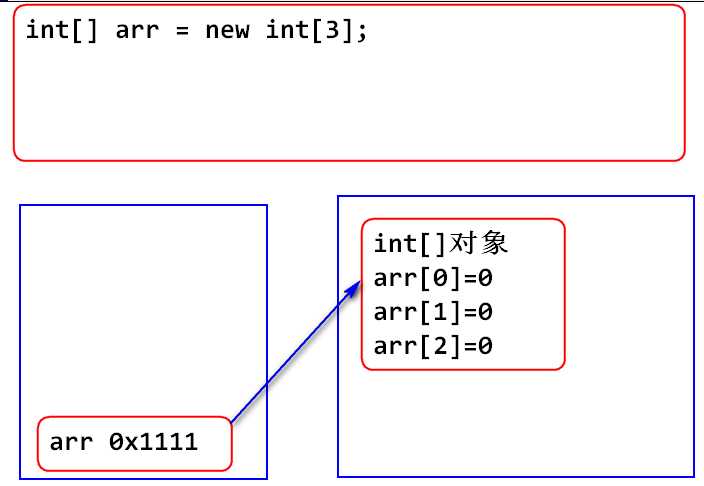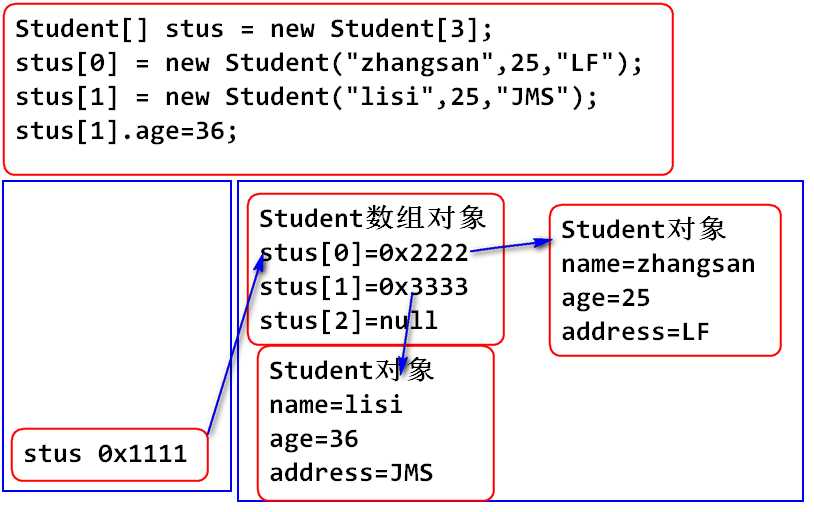 day03
day03
1.引用类型数组
1)先声明后赋值
Student[] stus = new Studenr[3];
stus[0] = new Student(“zhangsan”,25,”LF”);
stus[1] = new Student(“lisi”,26,”JMS”);
stus[2] = new Student(“wangwu”,27,”SD”);
stus[1].age = 36; //给 stus中第2个元素的年龄赋值为36
2)声明的同时赋值
Student[] stus = new Studenr[]{
new Student(“zhangsan”,25,”LF”),
new Student(“lisi”,26,”JMS”),
new Student(“wangwu”,27,”SD”)
};
3)int[]型的数组------------数组的数组
int[][] arr = new int[3][];
arr[0] = new int[2];
arr[0] = new int[2];
arr[0] = new int[2];
a[1][0] = 100; // 给 arr中第2个元素的第1个元素赋值为100
4)遍历数组的数组
int[][] arr = new int[3][4];
for(int i = 0;i<arr.length;i++){
for(j = 0;j<arr[i].length;j++){
a[i][j] = 100;
}
}


//引用类型数组测试类
public class StuTest {
public static void main(String[] args) {
Stu[] stus = new Stu[3]; //创建Stu数组对象
stus[0] = new Stu("zhangsan",25,"LF"); //创建Stu对象
stus[1] = new Stu("lisi",26,"JMS");
stus[2] = new Stu("wangwu",28,"SD");
System.out.println(stus[1].age); //26
for(int i=0;i<stus.length;i++){
System.out.println(stus[i].name);
stus[i].sayHi();
}
Stu[] ss = new Stu[]{
new Stu("zhangsan",25,"LF"),
new Stu("lisi",26,"JMS"),
new Stu("wangwu",28,"SD")
};
int[][] arr = new int[3][];
arr[0] = new int[2];
arr[1] = new int[3];
arr[2] = new int[2];
arr[1][0] = 100;
int[][] as = new int[3][4];
for(int i=0;i<as.length;i++){
for(int j=0;j<as[i].length;j++){
as[i][j] = 100;
}
}
}
}
2.继承
1)作用:代码复用
2)通过extends来实现继承
3)超类/父类:所有派生类所共有的属性和行为
派生类/子类:派生类所特有的属性和行为
4)派生类继承超类后,派生类具有:超类的+派生类的
5)一个超类可以有多个派生类
一个派生类只能有一个超类 -----------单一继承
6)继承具备传递性
7)java规定:构造派生类之前必须先构造超类
在派生类的构造方法中若没有调用超类的构造方法
-----则默认super()调用超类的无参构造方法
在派生类的构造方法中若调用超类的构造方法
-----则不再默认提供
super()调用超类构造方法必须放在最上面
3.super:指代当前对象的超类对象
super的用法:
1)super.成员变量名 ------------------访问超类的成员变量
2)super .方法名 ------------------------调用超类的方法
3)super() --------------------------------调用超类的构造方法
//super的演示
public class SuperDemo {
public static void main(String[] args) {
Boo o = new Boo();
}
}
class Coo{
Coo(int a){
}
}
class Doo extends Coo{
Doo(){
super(5);
}
/*
//如下代码,写不写都有
Doo(){
super();
}
*/
}
class Aoo{
Aoo(){
System.out.println("超类的构造方法");
}
}
class Boo extends Aoo{
Boo(){
//super(); //默认的(调用超类的构造方法)
System.out.println("派生类的构造方法");
}
}
